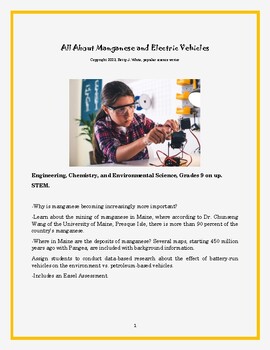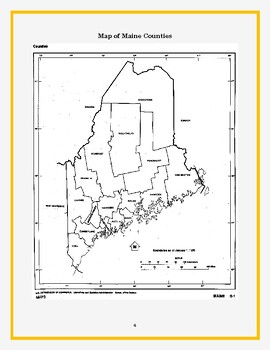Manganese and Electric Vehicles
Compass Rose
21 Followers
Grade Levels
9th - 12th
Subjects
Resource Type
Standards
NGSSHS-ESS3-4
Formats Included
- PDF
- Easel Assessment
Pages
8 pages
Compass Rose
21 Followers
Easel Assessment Included
This resource includes a self-grading quiz students can complete on any device. Easel by TPT is free to use! Learn more.
Also included in
- "Manganese and Electric Vehicles"... learn about Manganese in Maineand learn how to relax in the face of Climate Anxiety. Includes a short story by popular science writer, Betty J. White.... and an Easel Assessment. Grades 9 on up.And "Michigan: Its Chemistry and Geologic Wealth". Learn about the imPrice $14.66Original Price $20.95Save $6.29
- Here are three resources that make the connection between some of the most important elements in today's world, where they are found in the United States, and why they are essential.Making science meaningful through Chemistry... Biology... Space Exploration.Price $20.66Original Price $22.95Save $2.29
Description
Engineering, Chemistry, and Environmental Science, Grades 9 on up.
STEM.
-Why is manganese becoming increasingly more important?
-Learn about the mining of manganese in Maine, where according to Dr. Chunseng Wang of the University of Maine, Presque Isle, there is more than 90 percent of the country’s manganese.
-Where in Maine are the deposits of manganese? Several maps, starting 450 million years ago with Pangea, are included with background information.
Assign students to conduct data-based research about the effect of battery-run vehicles on the environment vs. petroleum-based vehicles.
-Includes an Easel Assessment.
Total Pages
8 pages
Answer Key
Included
Teaching Duration
2 Weeks
Report this resource to TPT
Reported resources will be reviewed by our team. Report this resource to let us know if this resource violates TPT’s content guidelines.
Standards
to see state-specific standards (only available in the US).
NGSSHS-ESS3-4
Evaluate or refine a technological solution that reduces impacts of human activities on natural systems. Examples of data on the impacts of human activities could include the quantities and types of pollutants released, changes to biomass and species diversity, or areal changes in land surface use (such as for urban development, agriculture and livestock, or surface mining). Examples for limiting future impacts could range from local efforts (such as reducing, reusing, and recycling resources) to large-scale geoengineering design solutions (such as altering global temperatures by making large changes to the atmosphere or ocean).








